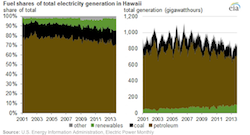Hawaii is addressing its lack of fossil fuels by converting its energy to renewables. The state imports nearly all of its energy, including the petroleum that fuels more than 70 percent electricity generation. This effort is the subject of the U.S. Energy Information Administration’s (EIA) latest Today in Energy report.
Another reason the state is attempting to diversify its electricity supply is since their electricity generation costs are tied closely to petroleum prices, residential electricity rates are three times the national average. The EIA explains that Hawaii’s islands are not connected by transmission lines, so each island must have enough generating capacity to meet local demand and provide emergency reserves.
 In the face of these challenges, Hawaii’s grid operators have turned to a combination of renewable sources (with lower costs than oil-fired generation), distributed generation, and energy efficiency programs that lower the overall demand for electricity in the state.
In the face of these challenges, Hawaii’s grid operators have turned to a combination of renewable sources (with lower costs than oil-fired generation), distributed generation, and energy efficiency programs that lower the overall demand for electricity in the state.
The petroleum share of electric generation has been declining, from a high of 81 percent in 2002 to 72 percent in 2013 (through November), while at the same time, generation from renewable sources has climbed from a 4 percent share in 2002 to more than 12 percent in 2013. Generation from coal comes from a single 180-megawatt (MW) facility on Oahu and has been relatively steady at 13-15 percent of total generation each year.
EIA has finds that total utility-scale electric generation has declined from 2007 through 2012. This reduction is attributable to distributed generation and net metering policies that encourage electric generation from homes and businesses, mostly from solar photovoltaic installations, and increased energy efficiency measures.
Hawaii produces renewable electricity from biomass, geothermal, and hydroelectric but recent new wind and solar projects have resulted in large increases in renewable electricity production. In 2012, wind accounted for 36 percent of total utility-scale renewable generation in Hawaii with an increase to 42 percent in 2013 (through November). Utility-scale solar generation has increased more than fivefold from 2012 to 2013 but still accounts for less than 2 percent of utility-scale renewable generation in Hawaii. However, EIA reports utility-scale data understate total solar generation in Hawaii because totals do not include the much larger output from small-scale solar power installations.
Hawaii’s installed renewable nameplate capacity in 2013 was just over 600 MW, more than triple the amount that in 2005. Nearly 57 MW of additional renewable capacity is currently under construction and slated to enter service during 2014.

